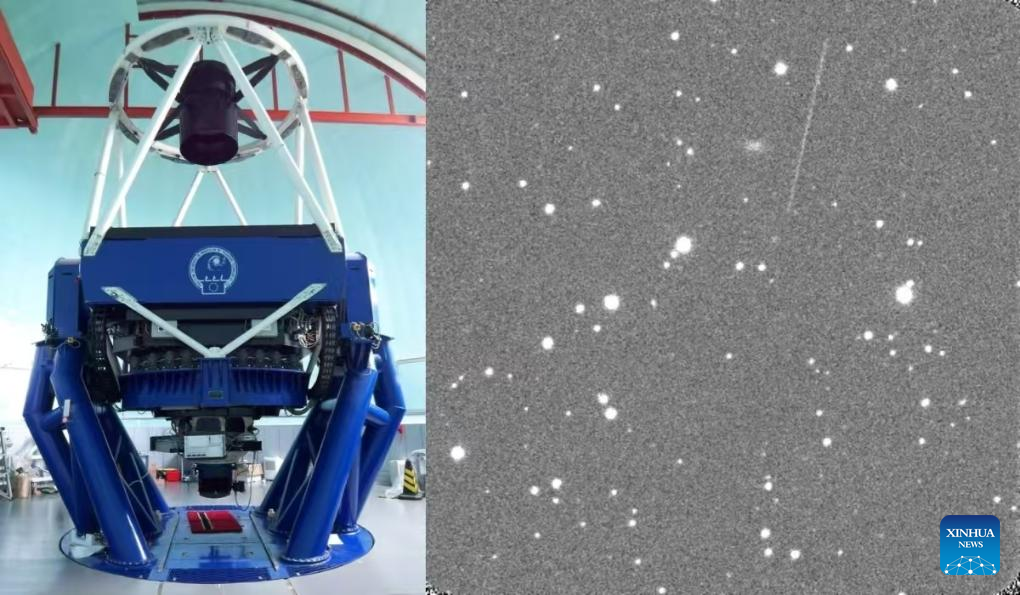


This combo photo provided by the Lijiang branch of the Yunnan Observatories under the Chinese Academy of Sciences (CAS) shows the telescope in Lijiang (L) and the image of asteroid 2024 XA1 (R, bright line). (The Lijiang branch of the CAS Yunnan Observatories/Handout via Xinhua)
KUNMING, Dec. 6 (Xinhua) -- Several observatories in China have captured rare images of a falling near-Earth asteroid, formally designated as 2024 XA1.
The images, along with the observation results of foreign observatories on the asteroid, mark the 11th successful early warning of an asteroid impacting Earth, and the 4th such prediction of 2024, according to China Science Daily on Friday.
The asteroid has an estimated diameter of between 75 centimeters and one meter. It was first discovered by a University of Arizona telescope at 5:55 a.m. (UTC) on Dec. 3, the report said.
China played a crucial role in monitoring the event due to its strategic geographic location.
The Lijiang branch of the Yunnan Observatories under the Chinese Academy of Sciences (CAS) detected the asteroid during the time from 3:10 p.m. to 3:30 p.m. (UTC) on Dec. 3 through its 2.4-meter telescope, said Zhang Xiliang, a researcher at the Lijiang observatory.
At 4:15 p.m. (UTC) on Dec. 3, the asteroid entered Earth's atmosphere over eastern Siberia and ignited, creating a bright fireball. The time between when the asteroid was first detected and its fall to Earth was less than 12 hours.
Telescopes at the CAS Purple Mountain Observatory (PMO), the Lenghu observatory in northwest China's Qinghai Province, and the Xingming Observatory in Xinjiang Uygur Autonomous Region, also in northwest China, all captured images of the asteroid.
Within two hours following the impact, the Minor Planet Center of the International Astronomical Union had received a total of 64 observations from around the world, and formally designated the asteroid as 2024 XA1, according to the report.
The destructive power of near-Earth asteroids impacting Earth is enormous, and early warnings and defense against such asteroids are of great importance to the safety of humanity. However, most near-Earth asteroids are not detected before they impact Earth due to our limited observation capacity, Zhang said.
"The achievement made this time will provide solid scientific support for China's efforts in early warnings and defense against near-Earth asteroids," he said.
The Lijiang observatory is located in a low latitude area with an altitude of over 3,200 meters, making it one of the best astronomical observation sites in China for night sky observations.
Zhang said that the research team at the Lijiang observatory formulated an observation plan based on forecast information and the characteristics of the asteroid six hours before it was expected to fall to Earth.
The team adopted a wait-and-see method at its designated position in anticipation of the fast-moving nature of 2024 XA1, and successfully captured precious images within the hour before its fall to Earth.
The observatory's 2.4-meter telescope is currently the largest general-purpose optical astronomical telescope in East Asia with the capability of tracking and observing fast-moving targets such as near-Earth asteroids with high precision.
The increasing success of asteroid-Earth impact predictions has been attributed to the continuous improvement of global near-Earth asteroid monitoring and warning capabilities.
The PMO also captured images of the asteroid approximately 42 minutes before its Earth impact.
The PMO is committed to researching methods to monitor and predict near-Earth asteroids, and actively advocates for the construction of a next-generation near-Earth object monitoring and warning network.
点击右上角![]() 微信好友
微信好友
 朋友圈
朋友圈

请使用浏览器分享功能进行分享
